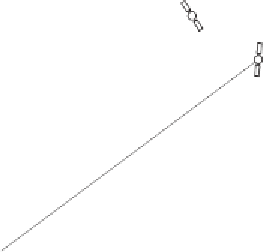Geoscience Reference
In-Depth Information
GPS satellites
LEO satellite
gradiometer
earth's surface
Fig. 7.10. Satellite gravity gradiometry with a three-axis gradiometer
where the gravitational signal arises from the attracting masses of the earth.
Thus, the measured signal corresponds to the gradients of the component
of the gravity acceleration, i.e., the second derivatives of the gravitational
potential. For instance, in obvious notation we read from Fig. 7.11
V
x
2
−
V
x
1
=
∆
V
x
∆
z
=
∂V
x
∂z
=
V
xz
.
(7-48)
∆
z
Summarizing the briefly described three methods, satellite-to-satellite track-
ing in high-low mode, satellite-to-satellite tracking in low-low mode, and
satellite gravity gradiometry, we may say that the basic observable is grav-
itational acceleration. Following Rummel et al. (2002), the case of satellite-
to-satellite tracking in high-low mode corresponds to a three-dimensional
position, velocity or acceleration determination of a LEO satellite. The three-
dimensional accelerometry corresponds to gravity acceleration. Mathemati-
cally, this is expressed by the first derivatives of the gravitational potential.
Considering the low-low mode, the principle corresponds to the line-of-
z
V
x1
z
x
V
x2
Fig. 7.11. Measuring the second derivative
V
xz























